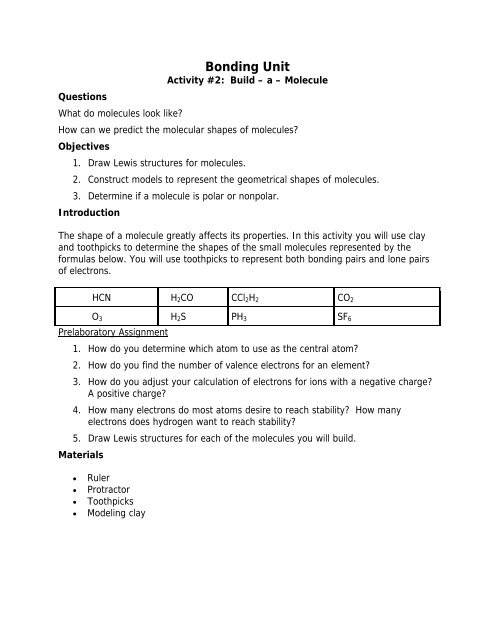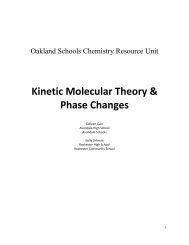You also want an ePaper? Increase the reach of your titles
YUMPU automatically turns print PDFs into web optimized ePapers that Google loves.
<strong>Bonding</strong> <strong>Unit</strong><br />
Activity #2: Build – a – Molecule<br />
Questions<br />
What do molecules look like?<br />
How can we predict the molecular shapes of molecules?<br />
Objectives<br />
1. Draw Lewis structures for molecules.<br />
2. Construct models to represent the geometrical shapes of molecules.<br />
3. Determine if a molecule is polar or nonpolar.<br />
Introduction<br />
The shape of a molecule greatly affects its properties. In this activity you will use clay<br />
and toothpicks to determine the shapes of the small molecules represented by the<br />
formulas below. You will use toothpicks to represent both bonding pairs and lone pairs<br />
of electrons.<br />
HCN H 2 CO CCl 2 H 2 CO 2<br />
O 3 H 2 S PH 3 SF 6<br />
Prelaboratory Assignment<br />
1. How do you determine which atom to use as the central atom?<br />
2. How do you find the number of valence electrons for an element?<br />
3. How do you adjust your calculation of electrons for ions with a negative charge?<br />
A positive charge?<br />
4. How many electrons do most atoms desire to reach stability? How many<br />
electrons does hydrogen want to reach stability?<br />
5. Draw Lewis structures for each of the molecules you will build.<br />
Materials<br />
• Ruler<br />
• Protractor<br />
• Toothpicks<br />
• Modeling clay
















